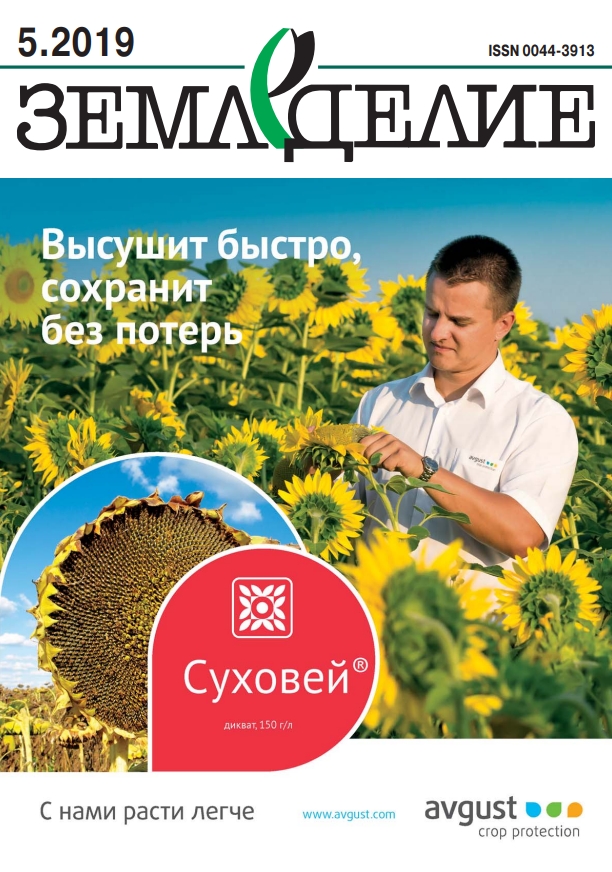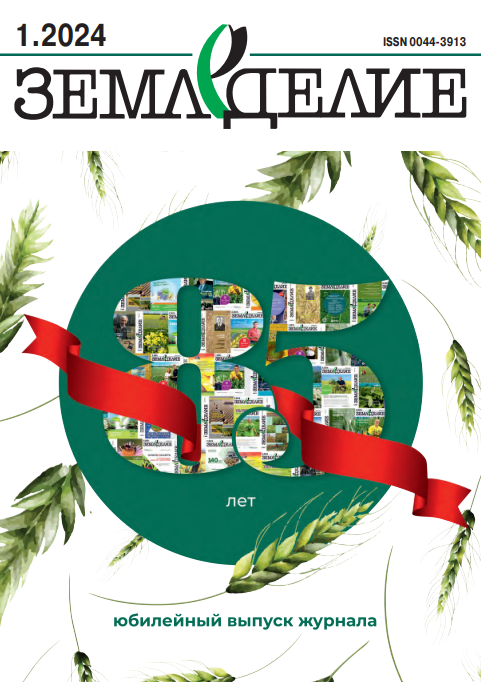Агротехнологическая оценка возделывания яровой пшеницы по различным предшественникам в условиях Курской области
DOI: 10.24411/0044-3913-2019-10506
УДК 631. 58.631.48:581:5
В. И. Лазарев, доктор сельскохозяйственных наук,зам. директора (e-mail: Адрес электронной почты защищен от спам-ботов. Для просмотра адреса в вашем браузере должен быть включен Javascript.)
Р. И. Лазарева, старший научный сотрудник
Б. С. Ильин, старший научный сотрудник
Т. В. Гаврилова, младший научный сотрудник
Курский федеральный аграрный научный центр, ул. Карла Маркса, 70 б, Курск, 305021, Российская Федерация
Представлены результаты многолетних стационарных исследований по комплексной оценке основных предшественников яровой пшеницы, используемых в почвенно-климатических условиях Курской области. Продуктивность яровой пшеницы на черноземных почвах региона подвержена значительным колебаниям по годам: от 1,72 до 4,55 т/га при размещении по сахарной свекле и от 1,74 до 4,75 т/га после кукурузы на силос. Величину урожайности яровой пшеницы в опытах на 53 % определяло влияние сложившихся погодных условий, на 17 % – уровень удобренности и на 12 % – предшественник. Лучший предшественник яровой пшеницы, обеспечивающий оптимальные условия для ее роста и развития – кукуруза на силос. При размещении яровой пшеницы в севообороте по кукурузе запасы продуктивной влаги перед посевом в слое почвы 0…25 см были выше на 2,4…3,0 мм, в слое 0…40 см – на 6,0…7,0 мм, в метровом слое – на 4,3…7,1 мм, в сравнении с размещением ее после сахарной свеклы. Это обеспечивало лучший азотный режим под яровой пшеницей. Запасы нитратного азота в слое почвы 0…40 см перед посевом яровой пшеницы, высеваемой после кукурузы, были на 1,8…2,3 кг/га выше, чем после сахарной свеклы. Размещение яровой пшеницы в севообороте после кукурузы на силос способствовало повышению урожайности на 0,20…0,24 т/га, увеличению содержания сырой клейковины в зерне на 0,5…0,6 %, в сравнении с возделыванием ее после сахарной свеклы.
Ключевые слова: чернозем типичный, яровая пшеница, предшественники, кукуруза, сахарная свекла, продуктивная влага, нитратный азот, засоренность, урожайность.
Для цитирования: Агротехнологическая оценка возделывания яровой пшеницы по различным предшественникам в условиях Курской области / В. И. Лазарев, Р. И. Лазарева, Б. С. Ильин и др. // Земледелие. 2019. № 5. С. 25–27. DOI: 10.24411/0044-3913-2019-10506.
Agrotechnological Evaluation of Spring Wheat Cultivation after Various Forecrops under Conditions of the Kursk Region
V. I. Lazarev, R. I. Lazareva, B. S. Ilyin, Т. V. Gavrilova
Kursk Federal Agrarian Scientific Cente, ul. Karla Marksa, 70 b, Kursk, 305021, Russian Federation
Abstract. The results of long-term stationary experiments on the integrated assessment of the main forecrops of spring wheat used under the soil and climatic conditions of the Kursk region are presented. It was established that the productivity of spring wheat on chernozem soils of the region significantly fluctuated over the years: from 1.72 to 4.55 t/ha when it was placed after sugar beets and from 1.74 to 4.75 t/ha when it was sown after corn for silage. The yield of spring wheat in the experiments was determined by the influence of the prevailing weather conditions by 53%, by the level of fertility – by 17%, and by the forecrop – by 12%. The results indicate that the best forecrop for spring wheat, providing optimal conditions for its growth and development, is corn for silage. When spring wheat was placed in the crop rotation after corn, the reserve s of productive moisture before sowing in the soil layer of 0–25 cm were higher by 2.4–3.0 mm, in thelayer of 0–40 cm – by 6.0–7.0 mm, in the meter layer – by 4.3–7.1 mm, than in the case of sugar beet as the forecrop. Higher reserves of productive moisture in the soil after corn provided the best nitrogen regime under spring wheat. The nitrate nitrogen reserve in the soil layer of 0–40 cm before sowing spring wheat after corn was 1.8–2.3 kg/ha higher than after sugar beet. The sowing of spring wheat in crop rotation after corn for silage contributed to an increase in the yield by 0.20–0.24 t/ha, an increase in the content of raw gluten in the grain by 0.5–0.6%, compared to its cultivation after sugar beet.
Keywords: typical chernozem; spring wheat; forecrops; corn; sugar beet; productive moisture; nitrate nitrogen; infestation; yield.
Author Details: V. I. Lazarev, D. Sc. (Agr.), Deputy Director (e-mail: vla190353@yandex.ru); R. I. Lazareva, senior research fellow; B. S. Ilyin, senior research fellow; Т. V. Gavrilova, junior research fellow.
For citation: Lazarev V. I., Lazarevа R. I., Ilyin B. S., Gavrilova T. V. Agrotechnological Evaluation of Spring Wheat Cultivation after Various Forecrops under Conditions of the Kursk Region. Zemledelie. 2019. No. 5. Pp. 25–27 (in Russ.). DOI: 10.24411/0044-3913-2019-10506.










